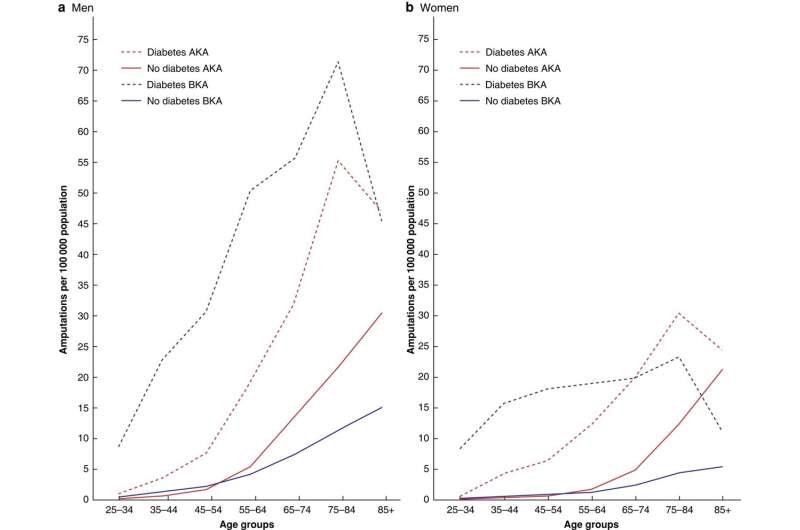This article has been reviewed according to Science X's editorial process and policies. Editors have highlighted the following attributes while ensuring the content's credibility:
fact-checked
trusted source
proofread
Worrying regional disparities found in lower limb amputation caused by arterial disease

A new study, led by researchers from the University of Sheffield and published in BJS Open, highlights the urgent need to improve care and prevention strategies, especially for people with diabetes. It also emphasizes the urgent need to address persisting regional disparities in health care access and outcomes.
Amputation rates in the North of England are the highest in the country with mortality rates within 90 days of amputation also higher in the North, the Midlands and London.
Patients in the North are also more likely to have above, rather than below, knee amputation which has an increased chance of complications and mortality.
Peripheral arterial disease, which is caused by a build-up of fatty deposits in the arteries to the legs, restricts blood supply and can be a debilitating condition. Major amputation of the lower limb is reserved as a treatment of last resort when other options do not exist or have failed.
Professor Ravi Maheswaran, Professor of Epidemiology and Public Health at the University of Sheffield's School of Medicine and Population Health, said, "Being told you need to have a leg amputated can be a devastating and frightening experience for patients and adjusting to life after amputation can be challenging.
"Health care professionals and policymakers must renew their commitment to combating peripheral arterial disease and its devastating consequences.
"While some progress has been made, the study emphasizes the urgent need to address the glaring regional disparities in health care access and outcomes."
Researchers at the University of Sheffield analyzed hospital admissions and census area data over a 12-year period from 2006 to 2018. During the study period there were a total of 47,249 major lower limb amputations due to peripheral arterial disease, resulting in an annual amputation rate of 11 per 100,000 individuals aged 25 and over.
These rates were notably higher among men and substantially higher in people with diabetes.
For patients undergoing above knee amputation, 25.3% had died within 90 days of the operation, compared with 11.9% for below the knee amputation.
Encouragingly, the study did reveal a decrease in amputation rates over time, particularly in the population with diabetes. Mortality within 90 days of amputation also exhibited a decline over the study period, while the percentage of patients with previous repair of arteries in the legs to try and avoid amputation also generally increased.
More information: Ravi Maheswaran et al, Time trends and geographical variation in major lower limb amputation related to peripheral arterial disease in England, BJS Open (2024). DOI: 10.1093/bjsopen/zrad140




















